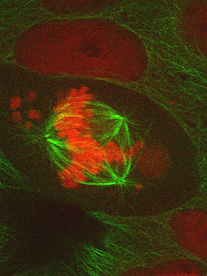| ESMTB School
Biology and Mathematics of Cells: Physiology, Kinetics and Evolution SigŁenza, Spain, June 11-22, 2001 |
 |
|
Red: chromatin staining. Green: microtubule visualization. (by Jany Vassy, AIPC Lab, IUH, Saint Louis Hospital, Paris, France)"
The Second School of the European Society for Mathematical and Theoretical Biology was held in SigŁenza, Spain, June 11-22, 2001. The First (Summer) School on Spatial Structures in Biology and Ecology: Models and Methods took place in Martina-Franca, Italy, September 4-15, 2000 (Web Page)
The SigŁenza school was also a follow-up of the School "Mathematics in Cell Physiology and Proliferation" which was held in Termoli, Italy, 6-19 June 1999. The school featured classical as well as novel aspects of cells, the building-up of material inside a single cell, the migration and aggregation of cells, the cell-cycle mechanism, cell proliferation of normal and abnormal cells, new techniques of exploration of the genome, and evolutionary aspects of cells. The school took place in the Seminary of SigŁenza which also accommodated the participants and the instructors. The entire Seminary was at the disposition of the school. The Seminary is a recent construction, with a number of class rooms of various sizes, surrounded by a large garden. It is a few kilometers away from the medieval town of SigŁenza, whose Parador, an old castle superbly renovated, and the Cathedral, will give the participants a pretext for pleasant evening excursions. SigŁenza is about 100 kilometers from Madrid, which can be reached by the regional train. The facilities of the school made it possible to organize the activities in such a way as to allow participants to select among some of the courses offered. The courses were divided into two groups: the morning courses (9:00-12:30) are the primary courses, devoted to the keynote subjects. They were intended for all participants. The afternoon courses (16:00-19:00) were the complementary courses. Some of these courses were given in parallel sessions; some of the complementary courses were repeated in several sessions, allowing for smaller groups and a better interaction of participants and teachers. Communications by participants were organized. Each course is divided into units of 40mn. Two formats for the communications: 10mn (appropriate for a work in progress, such as first year of a PhD, good to break the ice) and 20mn (for already well advanced or even completed work). There were ten days of classes, Monday through Friday, during two weeks. |
| Send questions to the webmaster |